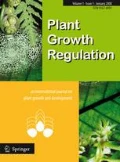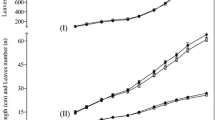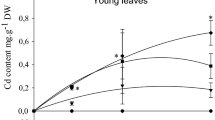Abstract
The aim of this study was to investigate Cd uptake of Populus alba Villafranca clone applying 0, 0.5 and 1 mg kg−1 soil DW of Cd (Cd c , Cd l and Cd h respectively) for 6 weeks. Cd allocation in the leaves, as a function of their position along the stem, was studied before its toxicity may alter physiological, biochemical and molecular biology of plants. Significant growth stimulation of roots (2.5 and 2.2 times more than control at Cd l and Cd h , respectively) and basal leaves (+79 and +55 % at Cd l and Cd h , respectively) was recorded when Cd was accumulated in a relatively higher concentration compared to other organs. In these experimental conditions, Villafranca clone can be considered a ‘‘root accumulator’’; in fact Translocation factor (Tf) calculated at leaves and stem levels were below 1. Even if Cd distribution among leaves did not change in function of their position, only apical leaves of Villafranca clone didn’t show changes in AsA and GSH concentration after Cd exposure as indication of different mechanism of Cd scavenge ability. A different expression of the genes related to antioxidant machinery such as GST, GPX and cAPX was observed in apical leaves, indicating that a strict regulation of the antioxidant defence system is required by poplar plant under Cd. All these energy consuming mechanisms were not found in more aged median and basal leaves. This could be a strategy adopted by Villafranca clone to avoid Cd effect in apical leaves, allowing plants to continue their growth without damages.
Graphical Abstract








Similar content being viewed by others
References
Ahmed H, Häder DP (2010) Rapid ecotoxicological bioassay of nickel and cadmium using motility and photosynthetic parameters of Euglena gracilis. Environ Exp Bot 69:68–75
Andresen E, Kupper H (2013) Cadmium toxicity in plants. In: Sigel A, Sigel H, Sigel RKO (eds) Cadmium: from toxicity to essentiality. Springer, Berlin, pp 395–413
Arnon DI, Hoagland DR (1940) Crop production in artificial culture solutions and in soils with special reference to factors influencing yields and absorption of inorganic nutrients. Soil Sci 50:463–483
Azevedo RA, Gratão PL, Monteiro CC, Carvalho RF (2012) What is new in the research on cadmium-induced stress in plants? Food Energy Secur 1:133–140
Benavides MP, Gallego SM, Tomaro ML (2005) Cadmium toxicity in plants. Braz J Plant Physiol 17:21–34
Berta M, Giovannelli A, Caparrini S, Racchi ML (2005) Expression of antioxidant genes in relation to water deficit in cambium and leaves of poplar. J Plant Interact 1:223–227
Brunner AM, Yakovlev IA, Strauss SH (2004) Validating internal controls for quantitative plant gene expression studies. BMC Plant Biol 4:14. doi:10.1186/1471-2229-4-14
Cosio C, DeSantis L, Frey B, Diallo S, Keller C (2005) Distribution of cadmium in leaves of Thlaspi caerulescens. J Exp Bot 412:765–775
Daud MK, Ali S, Variath MT, Zhu SJ (2013) Differential physiological, ultramorphological and metabolic responses of cotton cultivars under cadmium stress. Chemosphere 93:2593–2602
De las Rivas J, Abadía A, Abadía J (1989) A new reversed phase-HPLC method resolving all major higher plant photosynthetic pigments. Plant Physiol 91:190–192
Di Baccio D, Kopriv S, Sebastiani L, Rennenberg H (2005) Does glutathione metabolism have a role in the defense of poplar against zinc excess? New Phytol 167:73–80
Di Baccio D, Castagna A, Tognetti R, Ranieri A, Sebastiani L (2014) Early responses to cadmium of two poplar clones that differ in stress tolerance. J Plant Physiol 171:1693–1705
Dickmann DI (1971) Photosynthesis and respiration by developing leaves of cottonwood (Populus deltoides Bartr.). Bot Gaz 132:253–259
Dong J, Wu F, Zhang G (2006) Influence of cadmium on antioxidant capacity and four microelement concentrations in tomato seedlings (Lycopersicon esculentum). Chemosphere 64:1659–1666
Dos Santos Utmazian MN, Wieshammer G, Vega R, Wenzel WW (2007) Hydroponic screening for metal resistance and accumulation of cadmium and zinc in twenty clones of willows and poplars. Environ Pollut 148:155–165
Elobeid M, Gobel C, Feussner I, Polle A (2012) Cadmium interferes with auxin physiology and lignification in poplar. J Exp Bot 63:1413–1421
Fagioni M, Zolla L (2009) Does the different proteomic profile found in apical and basal leaves of spinach reveal a strategy of this plant toward cadmium pollution response? J Proteome Res 8:2519–2529
Francini A, Galleschi L, Saviozzi F, Pinzino C, Izzo R, Sgherri C, Navari-Izzo F (2006) Enzymatic and non-enzymatic protective mechanisms in recalcitrant seeds of Araucaria bidwillii subjected to desiccation. Plant Physiol Biochem 44:556–563
Genty B, Briantais JM, Bake NR (1989) The relationship between the quantum yield of photosynthetic electron transport and quenching of chlorophyll fluorescence. Biochim Biophys Acta 99:87–92
Gill SS, Tuteja N (2011) Cadmium stress tolerance in crop plants Probing the role of sulfur. Plant Signal Behav 6:215–222
Gruszecki W, Janik E, Luchowski R, Kernen P, Grudziński W, Gryczyński I (2009) Supramolecular organization of the main photosynthetic antenna complex LHCII: a monomolecular study. Langmuir 25:9384–9391
Jakovljević T, Cvjetko Bubalo M, Orlović S, Sedak M, Bilandžić N, Brozinčević I, Redovniković IR (2014) Adaptive response of poplar (Populus nigra L.) after prolonged Cd exposure period. Environ Sci Pollut Res 21:3792–3802
Kieffer P, Planchon S, Oufir M, Ziebel J, Dommes J, Hoffmann L, Hausman JF, Renaut J (2009) Combining proteomics and metabolite analyses to unravel cadmium stress-response in poplar leaves. J Proteome Res 8:400–417
Krebs RE (2006) The history and use of our earth’s chemical elements. A reference guide. Greenwood Press, Westport. pp 143–146
Livak KJ, Schmittgen TD (2001) Analysis of relative gene expression data using real-time quantitative PCR and the 2−ΔΔCT method. Methods 25:402–408
Lloyd G, McCown BH (1980) Commercially feasible micropropagation of mountain laurel Kalmia latifolia by use of shoot-tip culture. Comb Proc Int Plant Propag Soc 30:421–427
López-Millán AF, Sagardoy R, Solanas M, Abadía A, Abadía J (2009) Cadmium toxicity in tomato (Lycopersicon esculentum) plants grown in Hydroponics. Environ Exp Bot 65:376–385
Lux A, Martinka M, Vaculík M, White PJ (2011) Root responses to cadmium in the rhizosphere: a review. J Exp Bot 62:21–37
Madejón P, Ciadamidaro L, Marañón T, Murillo JM (2013) Long-term biomonitoring of soil contamination using poplar trees: accumulation of trace elements in leaves and fruits. Int J Phytoremediat 15:602–614
Marmiroli M, Imperiale D, Maestri E, Marmiroli N (2013) The response of Populus spp. to cadmium stress: chemical, morphological and proteomics study. Chemosphere 93:1333–1344
Nazar R, Iqbal N, Masood A, Iqbal MR, Syeed KS, Khan NA (2012) Cadmium toxicity in plants and role of mineral nutrients in its alleviation. Am J Plant Sci 3:1476–1489
Parmar P, Kumari N, Sharma V (2013) Structural and functional alterations in photosynthetic apparatus of plants under cadmium stress. Bot Stud 54:45–51
Pietrini F, Zacchini M, Iori V, Pietrosanti L, Bianconi D, Massacci A (2010a) Screening of poplar clones for cadmium phytoremediation using photosynthesis, biomass and cadmium content analyses. Int J Phytoremediat 12:105–120
Pietrini F, Zacchini M, Iori V, Pietrosanti L, Ferretti M, Massacci A (2010b) Spatial distribution of cadmium in leaves and its impact on photosynthesis: examples of different strategies in willow and poplar clones. Plant Biol 12:355–363
Romeo S, Francini A, Ariani A, Sebastiani L (2014) Phytoremediation of Zn: identify the diverging resistance, uptake and biomass production behaviours of poplar clones under high zinc stress. Water Air Soil Poll 225:1813–1825
Romero-Puertas MC, Corpas FJ, Rodriguez-Serrano M, Gomez M, Del Rio LA, Sandalio LM (2007) Differential expression and regulation of antioxidative enzymes by cadmium in pea plants. J Plant Physiol 164:1346–1357
Schützendübel A, Nikolova P, Rudolf C, Polle A (2002) Cadmium and H2O2-induced oxidative stress in Populus × canescens roots. Plant Physiol Biochem 40:577–584
Sebastiani L, Scebba F, Tognetti R (2004) Heavy metal accumulation and growth responses in poplar clones Eridano (Populus deltoides × maximowiczii) and I-214 (P. × euramericana) exposed to industrial waste. Environ Exp Bot 52:79–88
Smolders E, Mertens J (2013) Cadmium. In: Alloway BJ (ed) Heavy metals in soils: trace metals and metalloids in soils and their bioavailability. Springer, Dordrecht, pp 283–311
UNEP United Nations Environment Programme (2010) Annual report: harmful substances and hazardous waste. pp 77–87
Wan G, Najeeb U, Jilani G, Naeem MS, Zhou W (2011) Calcium invigorates the cadmium-stressed Brassica napus L. plants by strengthening their photosynthetic system. Environ Sci Pollut Res 18:1478–1486
White PJ, Brown PH (2010) Plant nutrition for sustainable development and global health. Ann Bot Lond 105:1073–1080
Wu FZ, Yang WQ, Zhang J, Zhou LQ (2010) Cadmium accumulation and growth responses of a poplar (Populus deltoids × Populus nigra) in cadmium contaminated purple soil and alluvial soil. J Hazard Mater 177:268–273
Yang X, Kalluri UC, Di Fazio SP, Wullschleger SD, Tschaplinski TJ, Cheng ZM, Tuskan GA (2009) Poplar genomics: state of the science. Crit Rev Plant Sci 28(5):285–308
Zhang F, Wan X, Zheng Y, Sun L, Chen Q, Zhu X, Guo Y, Liu M (2014) Effects of nitrogen on the activity of antioxidant enzymes and gene expression in leaves of Populus plants subjected to cadmium stress. J Plant Interact 9:599–609
Zornoza P, Sánchez-Pardo B, Carpena RRO (2010) Interaction and accumulation of manganese and cadmium in the manganese accumulator Lupinus albus. J Plant Physiol 167:1027–1032
Author information
Authors and Affiliations
Corresponding author
Additional information
Chiara Romè and Stefania Romeo have contributed equally to this work.
Electronic supplementary material
Below is the link to the electronic supplementary material.
Rights and permissions
About this article
Cite this article
Romè, C., Romeo, S., Francini, A. et al. Leaves position in Populus alba Villafranca clone reveals a strategy towards cadmium uptake response. Plant Growth Regul 79, 355–366 (2016). https://doi.org/10.1007/s10725-015-0139-6
Received:
Accepted:
Published:
Issue Date:
DOI: https://doi.org/10.1007/s10725-015-0139-6




